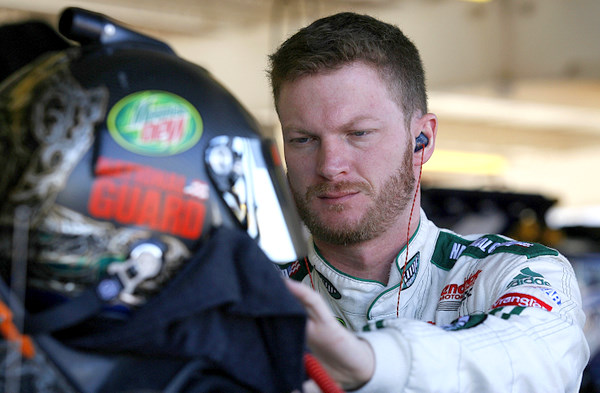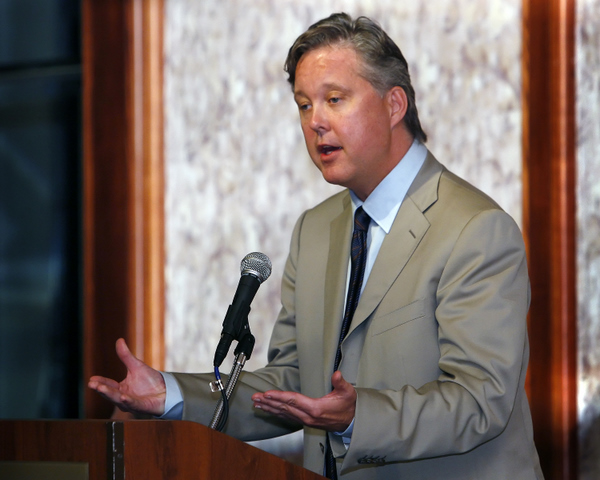And Dale Earnhardt Jr.'s Take: Cut speeds at least 10 mph....and NASCAR should stop blaming the drivers.

Dale Jr. prepares for battle (Photo: Getty Images for NASCAR)
By Mike Mulhern
mikemulhern.net
It's one of the late Dale Earnhardt's most famous quotes: "Why don't you tie a kerosene-soaked rag around your ankles so the ants won't climb up and eat your candy ass..."
It was pure Earnhardt….whose suggestion for NASCAR about Talladega was to raise the grandstands and throw away the restrictor plates and let the drivers run wide-open again.
In the wake of the Carl Edwards-Brad Keselowski last lap crash at Talladega Sunday, there is a lot of talk about what NASCAR should do to make things safer for the fans – seven were injured by flying debris – and the drivers.
So far NASCAR officials say they're studying the situation. And they are implying, rather strongly, that they'll be hitting drivers with penalties for overly aggressive driving.
Blaming the drivers doesn't set well with Dale Earnhardt Jr., who says "I would advise against doing anything extra, or being stricter.
"You run the risk of taking the race out of the drivers' hands.
"I think we do a good job of policing it pretty much on our own now.
"I mean, it is a race. First and foremost, we're out there racing. Blocking, weaving, carrying on is part of the game.

NASCAR president Mike Helton (C) and CEO Brian France, the men who must make the big decisions (Photo: Getty Images for NASCAR)
"I really haven't seen a true replay of the finish, but I seen some shots of it. There's two arguments there: You could say that Carl's block wasn't quite as aggressive as some you've seen in the past, and you could say that Brad had plenty of room -- he still had another foot and a half to the yellow line to give Carl…or you could say that Brad held his ground, did the right thing, did what it took to win.
"Nothing from that wreck really stands out to me as 'Wow, we've got to make a change here…or something needs to be done….'
"Other than the car getting off the ground and people getting hurt, as far as the wreck itself, trying to avoid it from happening, I don't see how you can.
"Guys are going to race hard, and they're going to be aggressive and try to win.
"I didn't see anything in the race up until that point that made me feel like somebody needed to step in, or NASCAR needed to do something. I never felt at any point in the race that NASCAR wasn't doing enough or somebody needed to be reprimanded.
"I think they do a great job the way it is.
"Part of me gets sort of a little bit angry -- because it's almost as if they're putting the responsibility, shoving the responsibility, for what happened Sunday, totally on the drivers' shoulders. As if all our crazy blocking and weaving has just ruined the day. Which isn't the case.
"As a driver, I share responsibility. But I don't feel like it's entirely ours for anything that happens.
"We all have to get out there and race no matter what the circumstances are. And people have raced in this sport under far, far more dangerous situations.
"We're in pretty good shape right now with how safe the cars are, what NASCAR's done to try to keep things within reason.
"It's hard to tell whether the wreck Sunday was an oddity, or whether that's something that could easily happen again, because we haven't seen it since Bobby's wreck (Bobby Allison, 1987) at the same track at the same spot. We haven't seen it in years.
"But how easily could that happen again? I think that's the question you got to ask yourself.
"We've changed some things around in the COT, and we have it running respectable, comfortable speeds. When I say comfortable, I mean speeds that shouldn't get your car off the ground -- until we all get locked together like we did at the end of that race. Then we can pick it up 10 miles an hour, or something like that, and run the ridiculous laps that we haven't been able to run in years.

The buck stops here, with NASCAR CEO Brian France....unless of course sister Lesa or uncle Jim want to step in with advice (Photo: Getty Images for NASCAR)
"NASCAR needs to think about what they can do to keep us from being able to obtain those speeds.
"That last lap of the race was the fastest lap by anybody. And Brad ran a lap average of 199 miles an hour pushing Carl.
"NASCAR is really wanting to see cars run around 190 mile-per-hour range. We are doing 10 more miles an hour, being able to tag up bumper to bumper like we are.
"That's where the threshold is for cars getting airborne -- about 195.
"We have to think what we can do to get back under that threshold and not create this situation in the future.
"I'm sure they'll make the right choice…whether it's no change at all.
"I feel pretty confident in NASCAR as a sanctioning body to do what's right.
"People have talked about changing the track. That's impossible to do. There's no way you can justify it under the current economic state of the sport.
"So the track is not going to change.
"They just need to look in some other areas.
"It's probably nothing really major that they need to do to keep us from having an accident again.
"I really enjoyed the race, other than that. I enjoyed the hell out of it.
"I enjoy racing at Talladega. I like running in the big packs.
"There's a part of you that wishes there was some sort of a handling that would come into play. The cars don't go fast enough to have a handling issue. There's literally no push or loose at any point during any lap of the race. They're just sitting there stuck to the track, and not running quite fast enough to challenge the corner at all.
"So I wish that was there.
"That would spread us out a little bit -- not allow us to drive into the side of each other, or go down in the corner four- or five-wide."
And then of course there is the issue of this sport's promoters actually using those big crashes as a blatant marketing tool.
That irks Earnhardt.
"There's a responsibility for NASCAR and for the media to understand the messages they send," he says.
"They have to know what the repercussions are, to however it's conveyed.
"For years and years they've been telling everybody 'Turn the TV on and watch the Talladega race…see when 'the big one' happens…see who's in the big one…see who can miss the big one…see who can win the race and not get caught up in the big one.
"It's just been on and on and on and on for years.
"Now everybody associates that type of action with Daytona and Talladega….which is fine if you're going to celebrate it.
"But now you can't sit here and turn around and change your opinion -- because everybody knew this was the possibility of the style of racing.
"We unfortunately had a terrible accident that some people were injured in.
"But that has been a possibility for years.
"So it's almost amusing to me that everyone's interest is all of a sudden perked by what happened, when that possibility was there all along.
"It's always been there. We just have been lucky."

Dale Earnhardt Jr. making a pit stop during Sunday's Talladega 500 (Photo: Getty Images for NASCAR)
© 2010-2011 www.mikemulhern.net All rights reserved.
Web site by www.webdesigncarolinas.com







Junior is right about cutting
Junior is right about cutting speeds ten MPH. Some of the trap speeds I saw on my tape of the race showed 205 entering Three by the leaders. The sport does not need 205 MPH anywhere. 190 or below is enough for Talladega.
If Junior is talking about NASCAR policing "aggressive driving" and blocking, then he has a point, because NASCAR can't even police the yellow line rule. Blaming drivers is correct insofar as drivers are causing the wrecks, but adding more rules is never the solution; it never works.
Racing is a dangerous sport.
Racing is a dangerous sport. It doesn't matter if it's Bowman Gray Stadium or Talladega. Danger comes with the territory.
People will get hurt and occasionally someone may die. Everyone hopes that every race will be safe with no injuries or deaths but sooner or later the odds catch up.
Yet drivers and crews continue to go out and race. It's what they do. And NASCAR sells that thrill of seeing these daring men a moments away from catastrophe to the masses.
As much as it may irk Jr. the element of danger from a wreck is part of what sells the sport. But he is right...it is a mixed message to use that danger to sell the sport but then turn around and penalize the drivers who just gave you the publicity you wanted for the next race. Let the racers race and work to keep things as safe as possible, especially for the fans.
I think NASCAR, for the most part, really does a good job of trying to make the cars and tracks as safe as possible. Part of the businees plan is to keep the sport as safe as possible to keep the masses tuned in to see exciting action but with everyone, including the fans, walking away safe afterwards.
The one thing I would change is to move the fans away from the fence. Keep them above a certain line. It's not a cure all but much safer than having people right in the line of fire of a car going in the fence. And with attendance down, it shouldn't be that hard to do. Just move everyone up to the empty seats and leave the bottom rows empty.
At most large tracks you can't see well down there anyway. I know, I've been down there. I saw more beer cans and chicken bones whiz by than I did cars.
But of course having empty rows of seats next to the fence doesn't look on TV so they won't do it. Even removing the seats leaves a large of void of space that doesn't convey the message of a full house.
So at what point is safety really more important than the business plan?
Cutting the speed won't
Cutting the speed won't help.
NASCAR needs to restore throttle response so the drivers can pass and repass. This will take away the need for blocking, which is what causes "The Big Ones".
In my opinion, either flatten the tracks ('Dega and Daytona) or introduce a smaller engine (6-cyl?). Then throw away the plates and let 'em race.
+ Leonard
Post new comment